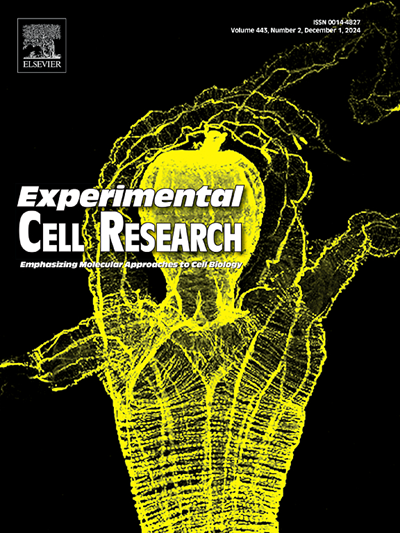将 SLC16A8 鉴定和验证为透明细胞肾细胞癌的预后生物标志物:六基因溶质载体特征
IF 3.3
3区 生物学
Q3 CELL BIOLOGY
引用次数: 0
摘要
溶质载体(SLC)蛋白是营养物质运输所必需的,影响肿瘤代谢和生长,同时保持细胞稳态。尽管这些转运蛋白具有重要的生物学功能,但它们作为透明细胞肾细胞癌(ccRCC)治疗靶点的适用性仍未得到充分研究。在目前的研究中,我们分析了转录组学数据,发现了77个SLC基因在ccRCC中差异表达,其中24个具有预测潜力。使用Lasso回归,我们开发了包含六个关键基因的预后特征:SLC2A3, SLC11A1, SLC14A1, SLC16A8, SLC22A6和SLC28A1。这一特征显示出强大的诊断性能,并作为患者生存的独立预测因子。进一步的分析整合了临床变量和风险评分,构建了对患者预后具有较高预测准确性的nomogram。免疫分析揭示了不同风险组之间不同的浸润模式:高风险患者表现出记忆B细胞、活化CD4+ T细胞、调节性T细胞(Tregs)、M0巨噬细胞和中性粒细胞水平升高。相比之下,他们的低风险对应物显示M1巨噬细胞,静止树突状细胞和静止肥大细胞。验证实验证实,与正常样本相比,SLC16A8在ccRCC组织中显著过表达,与预后不良相关。功能研究表明,SLC16A8敲除可在体外抑制肿瘤进展。与这些发现一致的是,体内实验表明SLC16A8敲除后肿瘤生长减少。从机制上讲,SLC16A8的降低减弱了PI3K/AKT信号,提示ccRCC进展的潜在调控途径。总之,我们建立了一个六基因SLC特征,在ccRCC中具有重要的预后价值。在这些基因中,SLC16A8是一个有前景的生物标志物和治疗靶点,值得进一步研究。本文章由计算机程序翻译,如有差异,请以英文原文为准。
Identification and validation of SLC16A8 as a prognostic biomarker in clear cell renal cell carcinoma: a six-gene solute carrier signature
Solute carrier (SLC) proteins are essential for nutrient transport, influencing tumor metabolism and growth while preserving cellular homeostasis. Despite the critical biological functions of these transporters, their applicability as therapeutic targets in clear cell renal cell carcinoma (ccRCC) remains largely unexplored. In the current study, we analyzed transcriptomic data and discovered 77 differentially expressed SLC genes in ccRCC, with 24 demonstrating predictive potential. Using Lasso regression, we developed a prognostic signature comprising six key genes: SLC2A3, SLC11A1, SLC14A1, SLC16A8, SLC22A6, and SLC28A1. This signature demonstrated strong diagnostic performance and served as an independent predictor of patient survival. Further analysis integrating clinical variables and risk scores enabled the construction of nomograms, which exhibited high predictive accuracy for patient outcomes. Immune profiling revealed distinct infiltration patterns between risk groups: high-risk patients showed elevated levels of memory B cells, activated CD4+ T cells, regulatory T cells (Tregs), M0 macrophages, and neutrophils. In contrast, their low-risk counterparts showed M1 macrophages, resting dendritic cells, and resting mast cells. Validation experiments confirmed that SLC16A8 was significantly overexpressed in ccRCC tissues compared to normal samples, correlating with poor prognosis. Functional studies demonstrated that SLC16A8 knockdown impaired tumor progression in vitro. Consistent with these findings, in vivo experiments demonstrated reduced tumor growth upon SLC16A8 knockdown. Mechanistically, decreased SLC16A8 attenuated PI3K/AKT signaling, suggesting a potential regulatory pathway in ccRCC progression. In summary, we established a six-gene SLC signature with significant prognostic value in ccRCC. Among these genes, SLC16A8 emerged as a promising biomarker and therapeutic target, warranting further investigation.
求助全文
通过发布文献求助,成功后即可免费获取论文全文。
去求助
来源期刊

Experimental cell research
医学-细胞生物学
CiteScore
7.20
自引率
0.00%
发文量
295
审稿时长
30 days
期刊介绍:
Our scope includes but is not limited to areas such as: Chromosome biology; Chromatin and epigenetics; DNA repair; Gene regulation; Nuclear import-export; RNA processing; Non-coding RNAs; Organelle biology; The cytoskeleton; Intracellular trafficking; Cell-cell and cell-matrix interactions; Cell motility and migration; Cell proliferation; Cellular differentiation; Signal transduction; Programmed cell death.
 求助内容:
求助内容: 应助结果提醒方式:
应助结果提醒方式:


